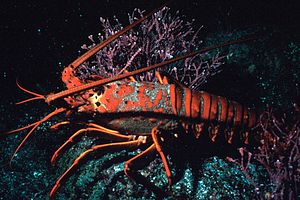Higher cancers
| Higher cancers | ||||||||
|---|---|---|---|---|---|---|---|---|

California lobster |
||||||||
| Systematics | ||||||||
|
||||||||
| Scientific name | ||||||||
| Malacostraca | ||||||||
| Latreille , 1802 | ||||||||
| Subclasses | ||||||||
|
The higher crustaceans (Malacostraca) are with around 28,000 species the most species-rich class within the crustaceans . In addition to the well-known crabs such as crabs , lobsters , crayfish , lobsters and shrimps, they also include the amphipods , woodlice and mantis shrimp , as well as various species-poor and rarely occurring groups such as the Thermosbaenacea .
anatomy

- The head (cephalon) consists of 6 segments with two pairs of antennae, as well as mandibles , 1st and 2nd maxillae as mouth parts . The two antenna-bearing segments and the segment in front of them are fused together.
- 8 breast segments each with a pair of legs (peraeopods).
- 6 abdominal segments. The extremities ( pleopods ) on the abdomen ( pleon ) originally have a swimming function.
- Eyes originally sit on movable stems.
- A two-chambered stomach, made of filter and chewing stomach in the back of the foregut.
- Central nervous system.
Systematics
The higher crab class is divided into three subclasses with a total of 16 orders. A more detailed presentation of the system can be found in the system of higher crabs .
- Subclass Eumalacostraca
- Superordination Eucarida
- Order Amphionidacea
- Order decapods (Decapoda)
- Order light shrimp (Euphausiacea)
- Superordinate sack shrimp (Peracarida)
- Order amphipods (amphipods)
- Order Cumacea
- Order woodlice (Isopoda)
- Order Lophogastrida
- Order Mictacea
- Order floating shrimp (Mysida)
- Order Spelaeogriphacea
- Order scissor lice (Tanaidacea)
- Order Thermosbaenacea
- Superorder Syncarida
- Order Anaspidacea
- Order water crabs (Bathynellacea)
- Superordination Eucarida
- Subclass Hoplocarida
- Order mantis shrimp (Stomatopoda)
- Subclass Phyllocarida
- Order Leptostraca
Fossils
Estimating the age and origin of the Malacostraca on the basis of the available fossil material is problematic. The oldest fossil Eumalacostraca come from the Devonian . However, there is agreement that the Phyllocarida are much older. Cambrian fossils, which are traditionally assigned to the phyllocarida, are extremely controversial in their actual phylogenetic position. Well-known fossils such as Canadaspis perfecta from the Canadian Burgess schist are very likely not phyllocarida, possibly not even Crustacea, other possible representatives such as Perspicaris , Plenocaris and Hymenocaris are just as controversial in their assignment. The oldest Malacostraca that are halfway certain in their assignment are the Archaeostraca, whose earliest representatives come from the end of the Cambrian. Of the most original Malacostraca, the Leptostraca, according to numerous phylogenetic models, there are no fossil finds at all. This means that the actual age of the group can hardly be reliably estimated.
swell
- Richter, S. & G. Scholtz: Phylogenetic analysis of the Malacostraca (Crustacea). In: J. Zool. Syst. Evol. Research. 39 2001: 113-136
Individual evidence
- ^ S. Richter & G. Scholtz: Phylogenetic analysis of the Malacostraca (Crustacea). In: J. Zool. Syst. Evol. Research. 39, pp. 113-136, 2001
- ↑ Jerzy Dzik, Andrey Yu. Ivantsov, Yuriy V. Deulin (2004): Oldest shrimp and associated phyllocarid from the Lower Devonian of northern Russia. Zoological Journal of the Linnean Society 142: 83-90.
- ^ Frederick R. Schram: The fossil record and evolution of Crustacea. In: Dorothy E. Bliss (editor): The Biology of Crustacea: Volume 1: Systematics, the fossil record, and biogeography. Academic Press, 1982 ISBN 0323139256
- ↑ Dieter Walossek: On the Cambrian diversity of Crustacea. In: Frederick R. Schram (editor): Crustaceans and the Biodiversity Crisis: Proceedings of the Fourth International Crustacean Congress, Amsterdam. Crustacean Issues 12. Brill Scientific Publishers, 1998. ISBN 9004113878
- ↑ Erik Dahl: Malacostracan Phylogeny and Evolution. In: Frederick R. Schram (editor): Crustacean Phylogeny. Crustacean Issues 1. Rotterdam: AA Balkema 1983. ISBN 906191 231 8
- ↑ Joseph H. Collette & James W. Hagadorn (2010): Early Evolution of Phyllocarid Arthropods: Phylogeny and Systematics of Cambrian-Devonian Archaeostracans. Journal of Paleontology Vol. 84, No. 5: 795-820.
- ^ Matthew A. Wills, Ronald A. Jenner, Ciara N. Dhubhghaill (2009): Eumalacostracan Evolution: Conflict between Three Sources of Data. Arthropod Systematics & Phylogeny 67 (1): 71-90.
Web links
- The class of higher crabs (Malacostraca). Tree of Life web project, accessed February 26, 2010 .
- The class of higher crabs (Malacostraca). In: Fauna Europaea Database. European Commission under the Fifth Framework Program, accessed February 26, 2010 .